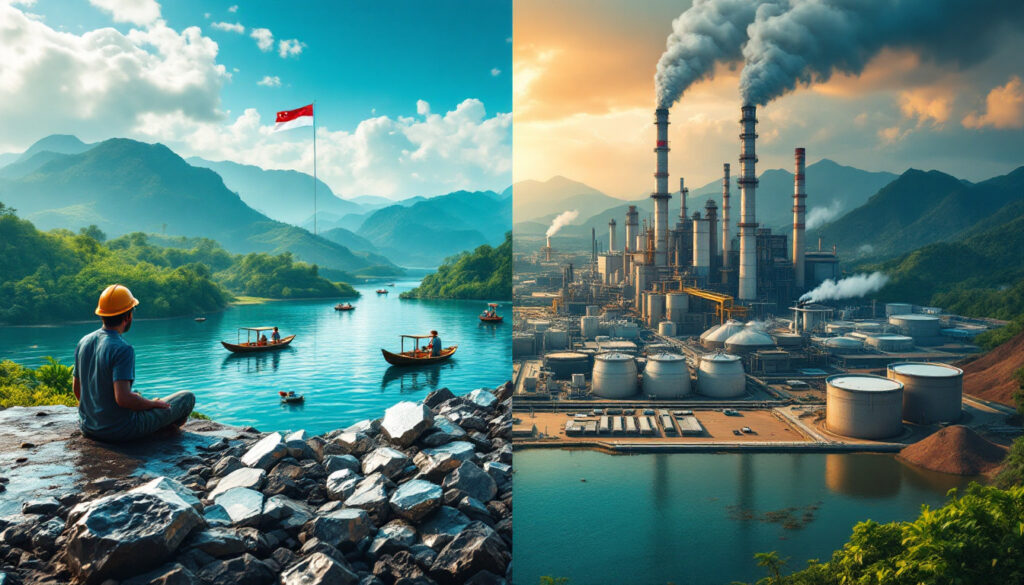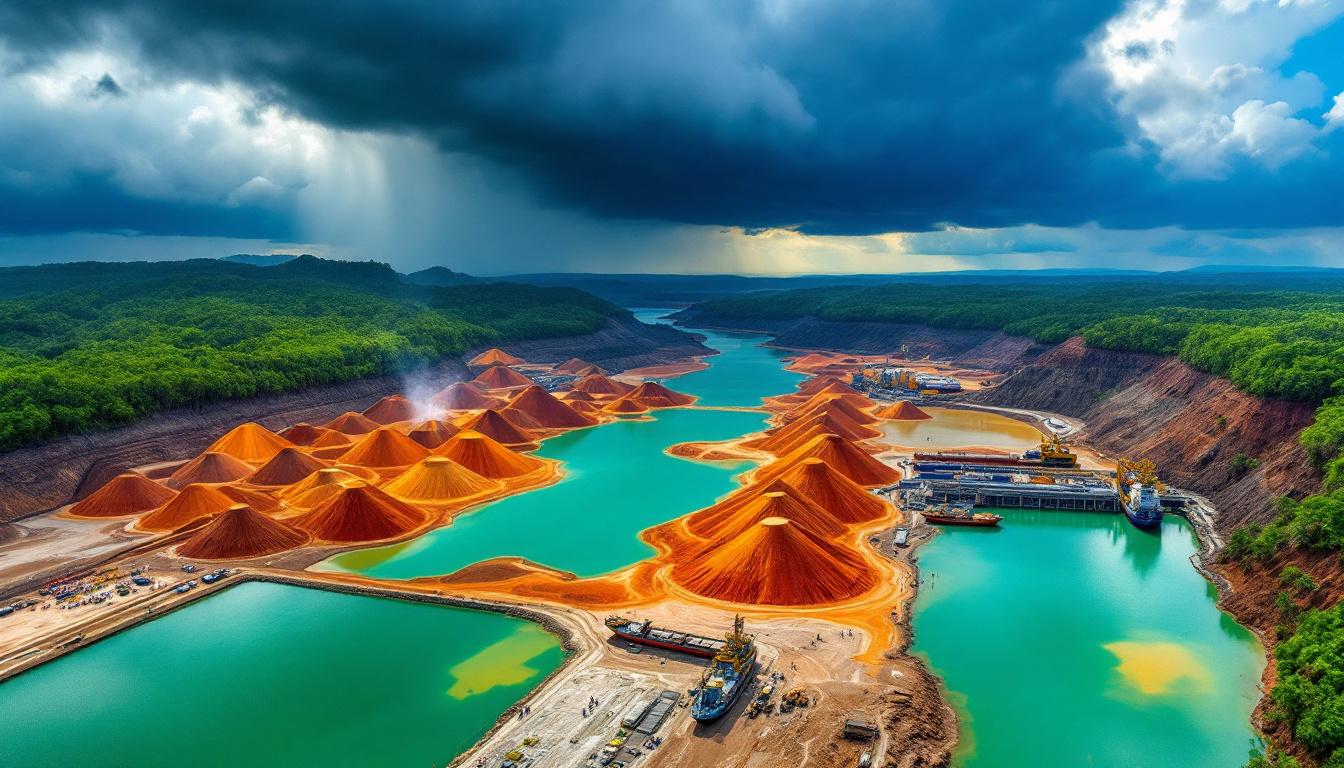How China's Investment in Indonesia's Nickel Industry is Impacting Local Communities
Indonesia's nickel industry, fueled by China's extensive investments, has transformed the nation into a global leader in nickel production. This growth, however, comes at significant environmental and social costs. Local communities face polluted waterways, health crises, and disrupted livelihoods, while the Indonesian government grapples with balancing economic development against sustainable practices and mining ESG challenges.
The Rise of Indonesia's Nickel Industry
Indonesia's Position in the Global Nickel Market
Indonesia holds the world's largest nickel reserves, with 5.2 billion tons of ore and 57 million tons of metal, constituting 42% of global reserves. These resources are concentrated in Sulawesi and Maluku, particularly in Bahodopi district, where rich deposits have attracted international attention. The country's strategic shift from raw ore exports to processed nickel products since 2020 has positioned it as a critical player in the electric vehicle (EV) battery supply chain and created opportunities for those looking to develop a mining investment guide.
The China-Indonesia Nickel Partnership
In 2013, Indonesia-based mining conglomerates partnered with China's Tsingshan Holding Group to establish the Indonesia Morowali Industrial Park (IMIP). Endorsed by Chinese President Xi Jinping and then-Indonesian President Susilo Bambang Yudhoyono, IMIP became a flagship Belt and Road Initiative (BRI) project. Over the past decade, China has invested over USD 65 billion, securing control of 90% of Indonesia's nickel mines and smelters.
This dominance gives China significant leverage over global EV manufacturing supply chains, as nickel is essential for lithium-ion batteries. The partnership represents one of the most successful implementations of China's resource strategy in Southeast Asia, creating an industrial ecosystem that benefits both nations economically while raising concerns about environmental oversight.
The Electric Vehicle Connection
The global transition to electric vehicles has dramatically increased nickel demand worldwide. High-grade nickel is a critical component in EV batteries, providing energy density and range capabilities that consumers demand. Indonesia aims to become a major player in the global EV market by 2027, leveraging its vast resources to move up the value chain.
IMIP's massive output of 4.76 million tons of nickel pig iron (NPI) annually primarily feeds China's stainless steel and battery industries, cementing the interdependence between the two nations. However, this close partnership has made it difficult for other investors to gain footholds in the sector, complicating Indonesia's efforts to diversify its economic relationships and explore digital mining innovations.
Environmental Impact on Local Ecosystems
Water Pollution Crisis
The environmental consequences of rapid industrialization have been severe. Previously crystal-clear waters around mining areas have turned opaque and polluted, with seawater in affected coastal regions turning brown. Local fishermen report depleted fish populations and must travel much farther to secure their catch.
Hot water discharge from power plants flows directly into the sea, raising water temperatures and damaging coral reefs and marine ecosystems. During rainfall, mining runoff turns waterways an orange-brownish color, carrying heavy metals and sediments downstream. Residents report skin irritation after contact with contaminated water, creating a public health crisis in communities that have traditionally relied on these water sources.
Air Quality Deterioration
Air pollution has become a daily reality for communities surrounding the industrial parks. Smelter furnaces release smoke approximately every six hours, turning the sky gray and reducing visibility. Black dust showers affect nearby villages, damaging clay roofs and contaminating homes.
Nickel processing plants release sulfur dioxide, nitrogen oxides, and coal ash into the atmosphere. IMIP's smelters are powered by coal-fired power plants, creating significant carbon emissions that contribute to both local pollution and global climate change. Environmental assessments suggest each 1 GW coal-fired power plant produces approximately 5 million tons of CO2 annually, making the industry's carbon footprint substantial.
Deforestation and Landscape Transformation
The physical transformation of the landscape has been dramatic. Once lush green hills have been converted into "giant brown mounds" as mining operations strip away vegetation and topsoil. The IMIP complex now spans more than 4,000 hectares—roughly equivalent to 5,600 soccer fields—of previously forested land.
Soil erosion from deforested hills pollutes waterways and agricultural land, creating a cascade of environmental impacts that extend far beyond the immediate mining sites. The runoff carries sediments containing nickel, chromium, and other heavy metals that can persist in the environment for decades, poisoning ecosystems and agricultural lands downstream.
Impact on Local Communities
Traditional Fishing Communities in Crisis
Indigenous communities like the Bajau in Kurisa village have witnessed their traditional livelihoods collapse. Local fisherman Joko reports: "In the past, we only needed to spread a net under our house, wait an hour, and we got 10 kilos. Now, we are grateful to be able to bring home five kilos of fish after sailing miles away for hours."
Many fishermen have abandoned their ancestral occupation entirely, unable to support their families as fish stocks dwindle. Only elderly fishermen remain in some villages, as younger generations seek employment in the mining sector or migrate to urban centers. This shift represents not just an economic change but the erosion of cultural practices that have defined these communities for generations.
Health Consequences for Residents
Upper respiratory infections have become the most prevalent health issue in Bahodopi district. Nearly 7,000 cases of respiratory problems have been reported since 2018, according to local health authorities. Healthcare workers attribute these respiratory issues directly to industrial dust and emissions.
Residents also report widespread skin conditions caused by polluted water. Many affected families cannot afford to access healthcare facilities, creating a silent epidemic of untreated conditions. Children have proven particularly vulnerable to these environmental hazards, with some requiring regular medical visits for persistent respiratory problems that interfere with their education and development.
Economic and Social Transformation
The industrial development has fundamentally altered the socioeconomic landscape. Young people have migrated from fishing and agriculture to working in mines and factories. IMIP now employs approximately 84,000 workers, including about 8,400 (10%) from China, creating a multicultural industrial ecosystem.
Workers face numerous challenges, including inadequate safety measures, extended working hours, short-term contracts (often just three months), low wages, and limited opportunities for advancement. Labor activist Katsaing from the Prosperous Indonesian Workers Union notes that many employees remain stuck in poverty despite working in one of Indonesia's most strategic industries.
New businesses have emerged to serve the growing industrial community. The complex now features its own airport, seaport, hotels, and dormitories, creating a self-contained industrial city where previously there were only small fishing villages and farms. This rapid urbanization has created opportunities for entrepreneurs but has also intensified economic inequality.
How Local Communities Are Adapting
From Fishing to Mining
The transition from traditional livelihoods to industrial employment has been challenging for many. Fisherman Lapola from Tapunggaeya village switched to mining work after fish stocks depleted, exemplifying a common trajectory. "Only the elderly still go fishing… Going out to sea has become futile," he explains.
Many young people have migrated to work in nickel mines or factories, learning new skills but often experiencing difficult working conditions. Those who cannot meet factory requirements continue in agriculture or open small businesses catering to industrial workers. Parking lots, street stalls, and repair shops have emerged to serve the industrial community, creating an informal economy around the nickel supply chain.
Health and Livelihood Challenges
Residents like Ani face ongoing health challenges for their families. Her child suffered from respiratory problems for two years, requiring regular visits to healthcare facilities they could barely afford. "The dust made him sick… We had no choice but to breathe the dirty air," she recounts.
The economic benefits of industrial development remain unevenly distributed, with many families struggling to adapt. Traditional knowledge and fishing practices are being lost as communities transition, representing an intangible cultural cost alongside the more visible environmental and health impacts, according to reports on nickel market dominance.
The Future of Indonesia's Nickel Industry
Production Scale and Economic Impact
IMIP now houses more than 50 smelters, producing 4.76 million tons of Nickel Pig Iron (NPI) annually. Most of this production is exported to China for further processing, though Indonesia has ambitions to develop its own downstream industries. The government aims to attract more diverse investors from the US and Europe to reduce its dependence on Chinese capital.
Despite these efforts, Chinese companies maintain their dominant position, with Indonesia facing challenges in reducing their influence in the sector. The economic benefits of nickel processing are substantial at the national level, but questions remain about how equitably these gains are distributed, as noted in global commodities insights.
Balancing Development and Sustainability
Environmental issues remain largely unresolved in Morowali and other nickel-producing regions. Local communities continue to bear the environmental and health costs of an industry that primarily benefits urban centers and foreign investors. The transition to EVs globally creates continued demand for Indonesian nickel, ensuring the industry's growth for decades to come.
The government faces difficult questions about whether the economic benefits of nickel processing outweigh the environmental and social costs. Regulatory frameworks remain inadequate to address the scale of pollution, while enforcement of existing environmental laws is inconsistent. According to a Carnegie Endowment report, sustainable nickel processing technologies exist but require significant investment that could reduce profit margins.
FAQ: China's Investment in Indonesia's Nickel Industry
What percentage of global nickel reserves does Indonesia hold?
Indonesia holds 42% of the world's nickel reserves, making it the largest repository of this critical mineral globally.
How much has China invested in Indonesia's nickel industry?
China has invested over USD 65 billion in Indonesia's nickel industry over the past decade.
What health problems are local communities experiencing?
Local communities report widespread respiratory infections (nearly 7,000 cases since 2018), skin irritation from polluted water, and other pollution-related health issues.
How has fishing been affected in nickel mining regions?
Traditional fishing has been devastated, with fish populations depleted due to water pollution, forcing many fishermen to abandon their traditional livelihoods.
What is the Indonesia Morowali Industrial Park (IMIP)?
IMIP is Southeast Asia's largest nickel-processing center, established through a partnership between Indonesian mining companies and China's Tsingshan Holding Group, spanning 4,000 hectares with 50+ smelters and employing 84,000 workers.
Ready to Discover the Next Major Mining Opportunity?
Stay ahead of significant discoveries on the ASX with Discovery Alert's proprietary Discovery IQ model, which delivers real-time notifications on potential mining opportunities before the market catches on. Start your 30-day free trial today and position yourself to capitalise on the next major mineral discovery.




